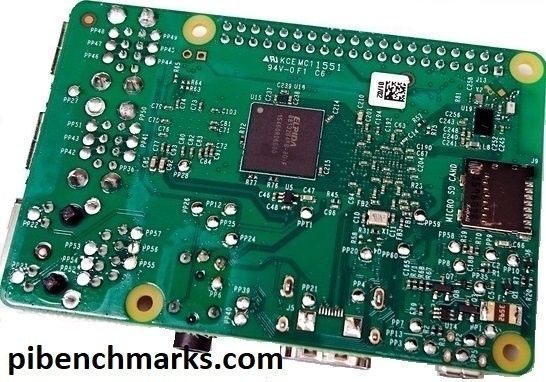
All of the previous generations of Raspberry Pi contained all of their firmware on the SD card. Starting with the Raspberry Pi 4 the device actually has onboard upgradable firmware stored on an EEPROM chip separate from your storage. Updating this firmware is very important as one of the first released updates reduces power usage of the Pi by 30% which also reduces how hot it gets.
In this guide I’ll show you how to update the bootloader firmware (no, it’s not apt-get upgrade, it’s a new utility called rpi-eeprom!) and also show you how to make a recovery SD card if your firmware gets corrupted and needs to be reflashed.
If you are looking for information on how to change the boot order on the Raspberry Pi 4’s new bootloader firmware, check out my New Raspberry Pi 4 Bootloader USB Booting Guide.
Upgrading the Bootloader Firmware
Requirements

The Raspberry Pi 4 is available in different memory configurations all the way up to 8 GB. It’s about the size of a credit card and uses an extremely low amount of power making it ideal for all sorts of projects and ideas!
Links: AliExpress*, Amazon.com*, Amazon.ca*, Amazon.com.au*, Amazon*.co.jp*, Amazon.co.uk*, Amazon.de*, Amazon.es*, Amazon.fr*, Amazon.it*, Amazon.nl*, Amazon.pl*, Amazon.se*, Amazon.sg*

The Raspberry Pi 400 kit includes everything you need for a full Pi 400 desktop build. The Pi 400 is the fastest Raspberry Pi ever released and comes in the form factor of a keyboard!
Links: AliExpress*, Amazon.com*, Amazon.ca*, Amazon.com.au*, Amazon.co.jp*, Amazon.co.uk*, Amazon.de*, Amazon.es*, Amazon.fr*, Amazon.it*, Amazon.nl*, Amazon.pl*, Amazon.se*, Amazon.sg*
To upgrade the firmware you should be running the latest Raspberry Pi OS. Do not attempt this from another distribution. If you want to use another distribution afterward that is great!
Since the Raspberry Pi bootloader firmware is stored on a chip on the device you can update it to the latest with Raspberry Pi OS and then go right back to using whatever you want. I personally have a separate SD card just for Raspberry Pi OS that I use to periodically plug in and update the firmware.
The firmware and the utilities around it are changing so quickly that you are really playing with fire not attempting this with the latest and greatest officially supported distribution when you are talking about firmware / on-board chips / etc.
With that word of caution out of the way, let’s get started!
Install rpi-eeprom (older versions of Raspberry Pi OS / Raspbian)
Newer versions of Raspberry Pi OS come with this utility already but if you are upgrading / have upgraded from an older version you may not have it in some cases. We can install it with the following commands:
sudo apt update sudo apt full-upgrade sudo apt install rpi-eeprom
Once the utility is installed Raspberry Pi OS will check at boot whether there are any critical bootloader firmware updates for your Pi.
Checking for Updates Manually
If you are like me and don’t want to wait around for Raspberry Pi OS to decide whether do these updates there is a command to check for updates manually:
sudo rpi-eeprom-updateYou will see output like this:
BCM2711 detected VL805 firmware in bootloader EEPROM BOOTLOADER: up-to-date CURRENT: Thu 3 Sep 12:11:43 UTC 2020 (1599135103) LATEST: Thu 3 Sep 12:11:43 UTC 2020 (1599135103) FW DIR: /lib/firmware/raspberrypi/bootloader/critical VL805: up-to-date CURRENT: 000138a1 LATEST: 000138a1
If the firmware isn’t up to date it will indicate an update is required like this:
BCM2711 detected VL805 firmware in bootloader EEPROM *** UPDATE AVAILABLE *** BOOTLOADER: update available CURRENT: Thu 3 Sep 12:11:43 UTC 2020 (1599135103) LATEST: Tue 24 Nov 15:08:04 UTC 2020 (1606230484) FW DIR: /lib/firmware/raspberrypi/bootloader/beta VL805: up-to-date CURRENT: 000138a1 LATEST: 000138a1
We now can see that there is updated firmware for our device. To install this update we will use the -a switch as well as the -d switch (which means to check the bootloader):
sudo rpi-eeprom-update -d -a
If there were updates available your output should look like this:
BCM2711 detected VL805 firmware in bootloader EEPROM *** INSTALLING EEPROM UPDATES *** BOOTLOADER: update available CURRENT: Thu 3 Sep 12:11:43 UTC 2020 (1599135103) LATEST: Tue 24 Nov 15:08:04 UTC 2020 (1606230484) FW DIR: /lib/firmware/raspberrypi/bootloader/beta VL805: up-to-date CURRENT: 000138a1 LATEST: 000138a1 BOOTFS /boot EEPROM updates pending. Please reboot to apply the update.
Reboot the Pi by typing sudo reboot and then run sudo rpi-eeprom-update again. This time it should tell you it is now up to date!
Changing rpi-eeprom’s Release Channel
By default you will only receive updates from Raspberry Pi OS “critical” channel. This is a very conservative firmware update channel that will only give you very well tested firmware updates that are considered critical fixes for the device. Another channel that is available is “stable”.
If you are trying to get USB boot support working and other recently added features I would try the “stable” channel first. It’s a lot more well tested and you’re less likely to run into any bleeding edge issues.
If you want to get the absolute latest firmware updates and fixes you may want to try the “beta” channel. These updates haven’t been tested as long and could potentially break your bootloader so Raspberry Pi OS only recommends using it if you are comfortable using the recovery tool to reflash your bootloader if something goes wrong. Check out the recovery section below for instructions on how to do this.
To switch to the beta channel we are going to edit the file /etc/default/rpi-eeprom-update:
sudo nano /etc/default/rpi-eeprom-update
Change the line FIRMWARE_RELEASE_STATUS=”critical” to:
FIRMWARE_RELEASE_STATUS="stable"
Or alternatively:
FIRMWARE_RELEASE_STATUS="beta"
Now you can run:
sudo rpi-eeprom-update -a
and you should see a new update available. You will need to reboot your Pi before the update is applied. I’d recommend rebooting it right away and run the check one more time and make sure it states you are now up to date.
View Bootloader Firmware Patch Notes
The latest official patch notes for all versions and changes are available in the rpi-eeprom GitHub repository
Disable Automatic Bootloader Firmware Updates
If you want to control when the updates are applied instead of leaving it up to Raspberry Pi OS the autoupdating service can be disabled with the following command:
sudo systemctl mask rpi-eeprom-update
The startup service has now been disabled and automatic bootloader firmware updates will only be applied if you do it manually.
To undo this and reenable the service we will use the unmask command:
sudo systemctl unmask rpi-eeprom-update
Now automatic firmware updates are enabled again!
Bootloader Recovery
The downside of having an onboard bootloader is that if something breaks reformatting your SD card will not fix it. In this section I will cover how to use the official tools to reflash and recover your Pi’s bootloader.
Requirements
To do this we need to prepare a SD card with the Raspberry Pi 4 EEPROM boot recovery tool. The easiest way to do this is to use the official Raspberry Pi Imager tool from the Raspberry Pi foundation to prepare the recovery image.
Here is how we create the recovery image inside the utility. Choose the “Misc utility images” category as shown below:
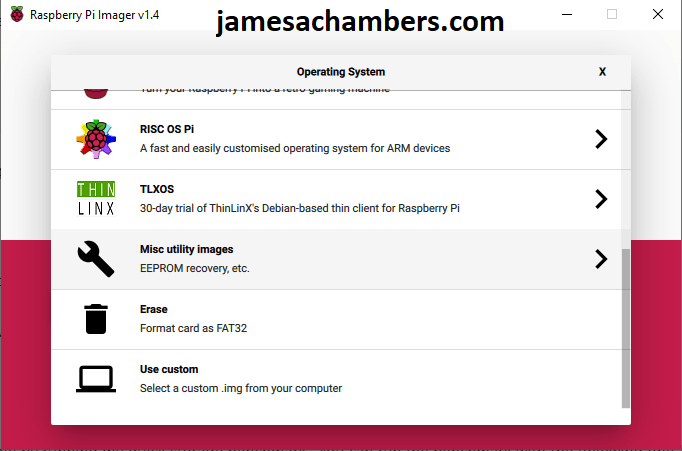
Next choose the “Bootloader (restore the factory default settings and change boot priority)” option:
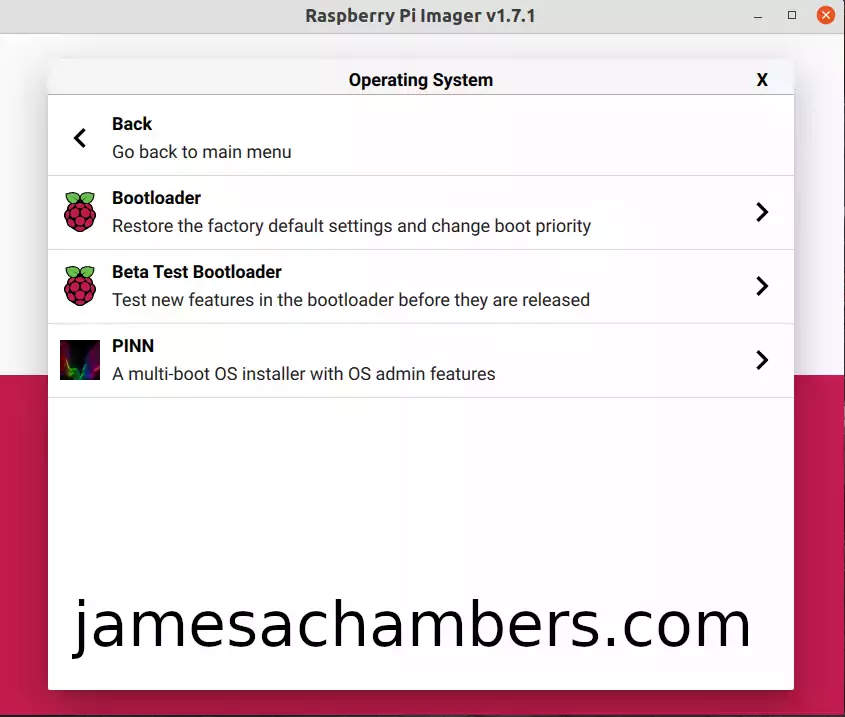
This will take you to a menu where you will select the default boot device for your Raspberry Pi like this:
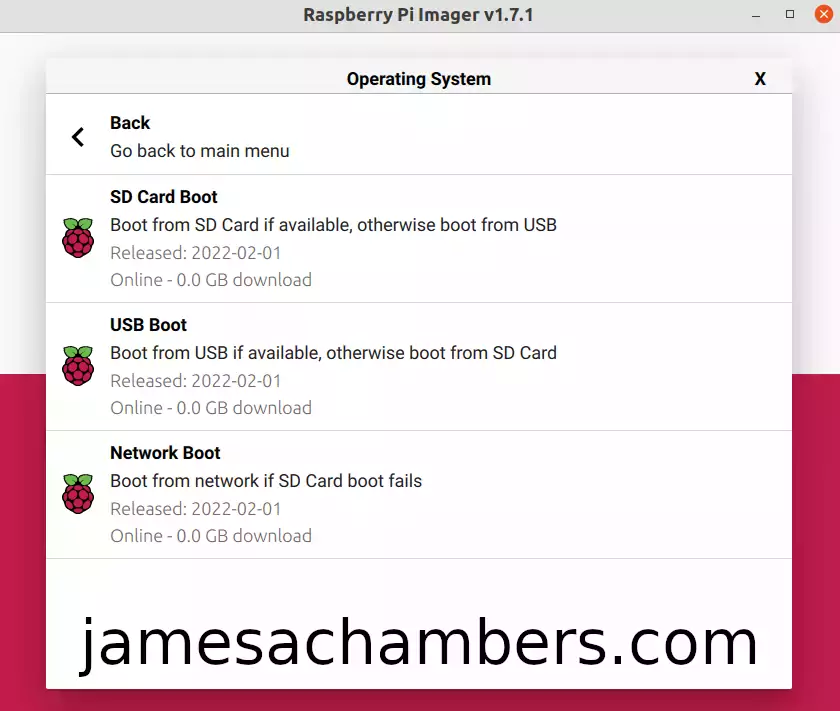
Notice that you are mostly just selecting the primary boot device. Modern versions of the firmware will fall back if the primary boot device fails. The first menu for example says “Boot from SD card if available, otherwise boot from USB”.
This means that if you took the SD card out you could still boot from a USB mass storage device if you selected the first option. Choosing the USB option would work similarly where if the USB mass storage boot failed it would fall back to booting from the SD card. Select the mode you would like and it should take you back to the main menu screen to pick the storage device to write to.
Next choose your SD card and then choose “Write”. Now unplug your Pi and put in the newly prepared SD card. Connect the power and let it boot. This will restore your bootloader to defaults. You should see a continuous rapid green blinking light. You may now disconnect the power and put your original SD card back / reinstall Raspberry Pi OS and boot the Pi normally!
When to Attempt Recovery
There is a simple procedure to tell if your bootloader is corrupt. Turn off your Pi completely and remove the SD card / all attached storage. Now plug your Pi back in with no storage media in it.
If your Pi’s bootloader is healthy you will see the green light blink a few times and then enter a pattern where it will blink 4 times and then have a long pause. It will repeat these 4 blinks / pause in an endless loop.
If your Pi’s bootloader is NOT healthy the green light will not blink. If this is the case it is time to do a bootloader recovery!
Another situation that can warrant a bootloader recovery is when your bootloader is missing a bunch of settings despite being up to date. For example other readers have seen cases where despite having the latest firmware according to rpi-eeprom-update they are missing key settings like the BOOT_ORDER setting. If anything is unusual with your settings many commenters have had success with this method when nothing else worked!
Recovery Procedure
Before powering up your device insert the “recovery” SD card that we made earlier in the requirements section above and make sure that all USB devices are removed. Even keyboards have been known to cause issues so make sure absolutely everything is unplugged!
Now insert the SD card into the Pi and connect the power.
If the bootloader recovery is successful the green activity light will start blinking rapidly continuously (forever). In this case you have successfully recovered your bootloader! You may now insert a normal fully imaged SD card and it will boot normally again.
If anything other than a continuous rapidly blinking green light happens the recovery was not successful.
If Recovery Doesn’t Work
- Try with a freshly imaged Raspberry Pi OS SD card. Sometimes there are unexpected things going on with an image that can prevent the newer firmware from being used (see next bullet point for example).
- Check your “boot” partition of your main OS and make sure there isn’t a file in there called “recovery.bin”. If this file is present it will load that version of the bootloader firmware instead of what is flashed on your Pi. This file should only be present on the “recovery” SD card we created but people are finding these files on their main OS “boot” partition. It’s worth checking to make sure it is not on the main OS SD card / drive you are trying to boot with.
- There is a known (and strange) issue with Raspberry Pi 4’s and 32 GB SD cards where the Pi will abort the boot. If this might apply to you then read this post.
- Make sure you created your SD card correctly. A common pitfall is using cards above 32 GB and formatting them with ex-FAT instead of regular FAT/FAT32.
- Make sure *all* USB devices are unplugged from the Pi
- Try a different SD card if you have one available. SD cards do go bad all the time. If there’s any doubt here check out my Raspberry Pi storage benchmarks page to see the highest performing SD cards (you definitely want an A1+ rated one).
- Check your power cord. Make sure you are using a high quality USB-C power cord that is compatible with the Pi. Even if it was working before I have had several old Pi power supplies that worked for years die on me. If there’s any doubt grab a known reliable one like the Canakit USB-C Raspberry Pi 4 Power Supply*
If you’ve gone through all the steps and are positive it’s not one of the above “gotcha” issues then it’s time to go deeper. You need to observe your Pi’s exact behavior when you plug it in (what the lights are doing). Here is a table of different blink patterns and what they mean:
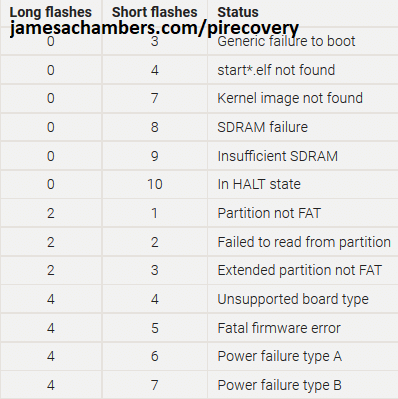
If your Pi’s LED behavior matches any of these codes then we now have much more to go on to diagnose why your Pi won’t boot. Some of them are very obvious but they’re all worth a quick web search once you have matched it to a code.
If your Pi’s behavior does not match one of these codes head to the official sticky post on the Raspberry Pi forums and scroll to the very bottom (post #4 specifically for Raspberry Pi). This tracks ongoing boot issues with the Pi 4 that may affect your Pi and a whole bunch of things to try. If you get through that post go all the way up to post #1 and start going down the list.
Could My Pi Be Dead?
It’s absolutely possible. Things like power issues (surges etc), wiring breadboards incorrectly, etc. can kill your Pi completely. That being said, if you have a Pi 4 that appears to be dead and you’ve gone through all my troubleshooting steps / the official sticky post / you aren’t covered by warranty then I would hold onto it for now as it’s still very new and some problems are still being investigated with the bootloader.
I have definitely killed a couple myself. I had a 3B+ that I had been using for a year building images (basically beating the crap out of it) on that finally had a hardware failure and would no longer boot. I wasn’t too sad about this one because I absolutely beat the crud out of these devices and push them to the absolute limit.
My more heartbreaking one was that I have killed a 4 GB Pi 4 that I got right at the Pi 4’s launch. I left this Pi in a very hot area running an experimental image that didn’t have proper firmware on it for about 2.5 weeks and now upon powering it up the green light will start blinking like it’s about to start booting then the green light will freeze and stay stuck on forever. I have a couple other Pi 4’s so I know all my cards and power supplies are good.
Make sure you’ve reviewed the official sticky post I linked in the previous section before jumping to this conclusion though. These things are not fragile and over all the years of running this blog it’s pretty amazing I’ve only killed 2 of them with the insane things I try on them all the time.
I may be able to help if you want to leave a comment here with *exactly* what behavior you’re seeing when you try these procedures, when you plug it in with no SD card in it, when you plug it in with a SD card in it, any little details will help!
Other Resources
For headless configuration of your Raspberry Pi using the Pi Imager
If you’re trying to setup USB mass storage booting (like with a SSD) check out my Raspberry Pi 4 Native USB Booting Guide
If you want to see which Pi storage performs the fastest and get an idea of what kind of drives to look for check out my 2020’s Fastest Raspberry Pi 4 Storage Benchmarks
If you have one of the new Raspberry Pi 400 kits *then don’t miss my Pi 400 Overclocking and SSD Setup Guide




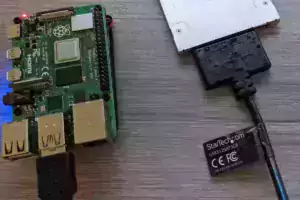

Hi James. I’m glad I read this blog -interesting questions have been raised!
Here’s another one for anyone out there: If I have a Compute Module CM4 with onboard eMMC then it will not access an external SD card. If there is a problem with the bootloader can it be fixed?
Hey John,
That is a great question! I have my Compute Module 4 (4GB RAM, 32GB eMMC) and the developer board on preorder from CanaKit. I don’t think it’s scheduled to ship until the end of January. Do you already have yours or are you waiting to get one? I know some people have them already like reviewers and insiders etc.
So even though I don’t have my hands on one yet I have done some reading about it and can point you toward some more information here. Basically, the answer is yes! Check out this newly updated documentation at the official Raspberry Pi docs site and scroll down to the “Flashing the bootloader EEPROM – Compute Module 4” section.
Fortunately it looks pretty painless and they did allow it to be reflashed from the eMMC relatively easily with the rpiboot utility!
Excellent article James. Thanks for this.
After a recent full upgrade I started getting the solid green LED problem and was unable to boot from a previously working SSD drive. I found that I had to revert to the April 2020 firmware to have my USB drive recognized at boot time. I find it hard to understand how such a serious problem has been left unfixed for so long.
Cheers
Hey phb-canada,
I agree! I’ve been seeing a *lot* of these problems lately. It’s interesting that you were able to fix it by reverting. That’s the first time I’ve heard of that. Most people have had to flash the recovery image to stop being stuck on an old config and get it to boot.
We’ve had some encounters with this before here as well as here.
Both of these users had to flash using the recovery image to get all of the current options back. One user (Maris) said he had to use an alternate storage device to actually update it and that it wasn’t updating through the SD card.
Today Victor is also having some problems and on his the recovery image hasn’t seemed to fix yet.
I’m not sure what the deal is, but definitely I’ve been seeing a lot of problems with this process. The recovery image seems to fix most of them, but some people continue to have trouble and have had to use different storage devices, etc. and others are yet unsolved!
Hi James,
I’ve updated to the latest beta version of the bootloader to try and solve the issues I’m having with not booting from USB and I stumbled across an earlier comment in this article regarding the boot folder being incorrect for Ubuntu… realizing now that Ubuntu 20.04 probably isn’t working with a simple fix, but I’m hoping you might be able to shed a little more light on the comment from STEK29 above. I tried to follow the comment that TIM wrote on Nov, 6, but got lost in the details.
I can boot Ubuntu via microSD slot, but if I take that same card and try and boot from a USB adapter in the USB3 port, it boots to a UBOOT command with everything being uninitialized.
Thanks in advance for the help.
Ubuntu mounts BOOTFS at different location (/boot/firmware compared to Raspbian’s /boot):
ubuntu $ mount | grep mmcblk0p1/dev/mmcblk0p1 on /boot/firmware
raspbian $ mount | grep mmcblk0p1
/dev/mmcblk0p1 on /boot
Because of that rpi-eeprom-update script won’t do anything on ubuntu (since it copies installation files to wrong directory)
so to update rpi eeprom/vl805 fw on ubuntu you’d need the following command:
sudo BOOTFS=/boot/firmware ./rpi-eeprom-update -a
official scripts can be used on ubuntu (if you have vc userland tools), and tools can be installed in ubuntu via libraspberrypi-bin package.
I had to do an SD card recovery, and it looks like the green LED pattern has changed behavior when no boot device is present. It now blinks green twice very rapidly, then the green LED stays on.
CURRENT: Thu 03 Sep 2020 12:11:43 PM UTC (1599135103)I wanted the newly released usb boot feature. I didn’t want the buggy beta version of that. Apparently there is now a “stable” branch of the firmware at github.
I changed /etc/default/rpi-eeprom-update to read:
FIRMWARE_RELEASE_STATUS="stable"It worked!
Today, 29 May 2020,I did a ‘full-upgrade.’ Now my Rpi4 4GB no longer boots. I tried both the latest BETA rpi-boot-eeprom-recovery and the earlier one dated 2020-04-16. Both, after installed on a 32 GB SD card and booted on the Pi4, gives the same continuously blinking green light, and the green screen, supposedly indicating a successful action. However, both give the same indication afterwards when booting the regular OS card:
board: c03111boot: mode 6
...
config.txt not found
Read recover4.elf bytes 760544
fixup4rc.dat not found
Missing/empty 'fixup4rc.dat'
...
recover4.elf: is not compatible 0x0
This board requires newer softwate. Get the latest...
What next steps could I attempt to get this to work again. I also tried booting an original 16 GB SD card, with the same results as noted above.
I recognized the same problem with my Rpi4 and USB pendrive on last day.
I fixed it with the new *.elf and *. dat files.